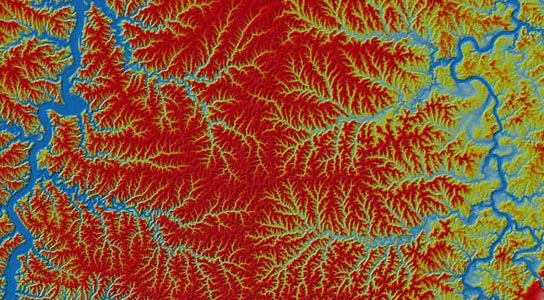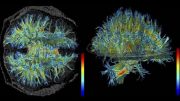
Branching river networks in the Allegheny Plateau in Pennsylvania and West Virginia. Credit: Taylor Perron/MIT
The precise conditions that cause rivers to form branches have long been a mystery, until now. A new study pinpoints two opposing physical forces that work together to produce the intricate patterns of rivers. This could help scientists understand rivers at all scales, even on other worlds.
The scientists published their findings in the journal Nature. When rain hits a tilted surface, it tends to flow toward the existing depressions. The flow of water erodes the rock, widening and deepening the depressions. This process is called incision, and it could be characterized as competitive and even cannibalistic. As the individual rills grow from incision, they capture smaller neighbors, forming tributaries. Instead of spreading indefinitely, a process called soil creep smooths over the land, filling in the cracks with a slow, yet steady drift of soil.
Researchers have known for more than a century that these processes shape rivers, but they hadn’t been able to quantify their relative importance or figure out how they work together to create river basins that are finely branched in some landscapes and not in others.
The scientists guessed that a certain ratio between rates of incision and soil creep acted like a tipping point for the creation of river branches. Below this value, they expected no tributaries to form. Above it, rivers would begin to capture smaller rivers and form a network of tributaries.
They compared California’s Salinas Valley with the Allegheny Plateau in southwest Pennsylvania, each with a 25 km2 region that contains thousands of river basins. The rivers in California are four times as branched as the ones in Pennsylvania. Neither region is strongly influenced by the faults and folds of a tectonic boundary. This allowed the team to compare Incision and soil creep without too much interference from other variables.
Once the river networks were mapped, the team created a mathematical model that included the equations for soil creep and incision in river channels surrounded by raised mountain ridges. The model was manipulated to see if it could produce the same branching patterns. This helped them identify a tipping point, which is a dimensionless value between 250 and 300, where incision overrides soil creep. When the models went beyond the tipping point in accelerated geological time, the valleys bloomed as they cannibalized their neighbors. Below the critical value, the river will shrink back to the size of its neighbors and ultimately lose its tributaries.
The researchers believe this kind of analysis could be applied to the rivers of methane on Titan, Saturn’s moon.
Reference: “The root of branching river networks” by J. Taylor Perron, Paul W. Richardson, Ken L. Ferrier and Mathieu Lapôtre, 5 December 2012, Nature.
DOI: 10.1038/nature11672









Be the first to comment on "River Formation Due to Interplay Between Incision and Soil Creep"